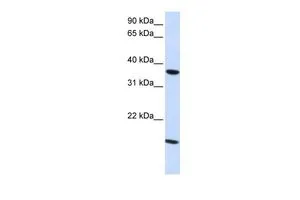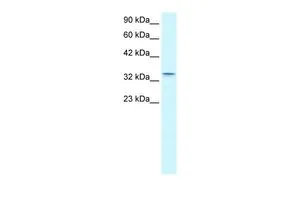
WB analysis of human fetal kidney tissue using GTX47761 Claudin 16 antibody at 1.25microg/ml.
Claudin 16 antibody, C-term
GTX47761
ApplicationsWestern Blot
Product group Antibodies
TargetCLDN16
Overview
- SupplierGeneTex
- Product NameClaudin 16 antibody, C-term
- Delivery Days Customer9
- Application Supplier NoteWB: 0.2-2.5 ug/ml. *Optimal dilutions/concentrations should be determined by the researcher.Not tested in other applications.
- ApplicationsWestern Blot
- CertificationResearch Use Only
- ClonalityPolyclonal
- Concentration0.5-1 mg/ml
- ConjugateUnconjugated
- Gene ID10686
- Target nameCLDN16
- Target descriptionclaudin 16
- Target synonymsHOMG3, PCLN1, claudin-16, hypomagnesemia 3, with hypercalciuria and nephrocalcinosis, paracellin-1
- HostRabbit
- IsotypeIgG
- Protein IDQ9Y5I7
- Protein NameClaudin-16
- Scientific DescriptionTight junctions represent one mode of cell-to-cell adhesion in epithelial or endothelial cell sheets, forming continuous seals around cells and serving as a physical barrier to prevent solutes and water from passing freely through the paracellular space. These junctions are comprised of sets of continuous networking strands in the outwardly facing cytoplasmic leaflet, with complementary grooves in the inwardly facing extracytoplasmic leaflet. The protein encoded by this gene, a member of the claudin family, is an integral membrane protein and a component of tight junction strands. It is found primarily in the kidneys, specifically in the thick ascending limb of Henle, where it acts as either an intercellular pore or ion concentration sensor to regulate the paracellular resorption of magnesium ions. Defects in this gene are a cause of primary hypomagnesemia, which is characterized by massive renal magnesium wasting with hypomagnesemia and hypercalciuria, resulting in nephrocalcinosis and renal failure. This gene and the CLDN1 gene are clustered on chromosome 3q28. [provided by RefSeq, Jun 2010]
- Storage Instruction-20°C or -80°C,2°C to 8°C
- UNSPSC12352203





